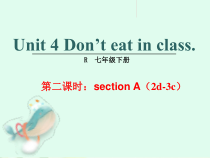 PPT
PPT
【文档说明】《Unit 4 Don’t eat in class》优质课件3-七年级下册新目标英语【人教版】.ppt,共(18)页,5.204 MB,由小喜鸽上传
转载请保留链接:https://www.ichengzhen.cn/view-103017.html
以下为本文档部分文字说明:
Unit4Don’teatinclass.第二课时:sectionA(2d-3c)R七年级下册1.Review:Tellothersaboutyourschoolrules.Inourschool,wecan’tliste
ntomusicinclass…Warm-up1.Learnnewwordsandphrases,thenmemorizethemassoonaspossible.2.Let’scheck.1)Readthephoneticsandspellwords.[ɪm'pɔːt(ə)nt]
adj.重要的[weə]v.穿,戴[brɪŋ]vt.带来;促使;['kwaɪət]adj.安静的;温顺的['juːnɪfɔːm]n.制服2)Chinese-Englishtranslation.Beontime;穿校服;alotof;必须
,不得不;bequiet;音乐播放机;dreamschoolLead-in2dRole-playtheconversation.1.Listenandcompletethetaskonyourlearningpa
perandcheckanswers.2.Groupwork.Readtheconversationandlearnaboutthemeaning.Underlinethedifficultieswhileyouarereading.3.Role-playthecon
versationinpairs.1.first1).形容词,“最早的,第一的”。4)常用短语:firstandlast完全地;atfirst起初;firstofall首先,第一。2)数词,“第一”,其前通常加定冠词the。3)副词,“最初;首先”。Let’sTakeSomeNotes2.Imp
ortant形容词,“重要的”常用句型:Itisimportantforsb.todosth.“做某事对某人来说是重要的”Eg.对我们来说遵守规则是重要的。Itisimportantforustofollowtherules.
钱2222GrammarFocus1.Readthesentences;2.FindoutGeneralQuestionsandSpecialQuestions.3.DosomeexplanationonImperativeSentences,ModalVerbsmu
standhaveto.祈使句(ImperativeSentences)1.概念(1)祈使句是指用来表示请求、命令、叮嘱、建议等的句子。祈使句没有主语,谓语动词用原形,句末使用感叹号或者句号。(2)如果祈使句表示客气地请求,一般要加上please。Eg.Pleasereadafterme.=
Readafterme,please.(请求)您的标题2.祈使句的形式(1)let开头的祈使句肯定句:Let’s+v.(原形)+其他.否定形式:1°Don’t+let+第三人称代词+v.(原形).2°Let’s+not+v.(原形).eg.不要让他们进来。Don’tletthemco
mein.eg.咱们别那样做了。Let’snotdothatagain.(2)非let开头的祈使句:肯定句Do型:v.原形(+宾语)+其他成份.eg:Listentome,please.请听我说。Be型:Be+表语(名词或形容词)+其他成份
.eg:Bequiet,please.请安静。否定句1°Don’t+行为动词+其他.eg:Don’tplaycomputergames.不要玩电脑游戏。2°Don’t+be+其他.eg:Don’tbelateagain.不要再迟到。3°No+n./v.-ing.(表示禁止、不准)eg:Nopho
tos.不许拍照。Noswimming.不许游泳。情态动词must与haveto1.must的用法(1)表示有做某一个动作的必要和义务,它的意思是“必须、应该”。(2)表示有很大把握的判断或者推测,意思是“
一定、准是”。2.haveto的用法haveto表示客观需要做的事情,意思是“必须,不得不”。(2)haveto有人称、数和时态的变化,其第三人称单数形式为hasto。(3)含有haveto,hasto的句子变疑问句或否定句需分别借助助动词do,does。(1)haveto后接动词原形,意为“必须
做……;不得不做……”。否定形式是:主语+don’t+haveto+动词原形+其他.(一般现在时,当主语是第三人称单数时,用doesn’thaveto,—般过去式用didn’thaveto)2.haveto的用法3aW
ritetherulesfortheschoollibrary.LibraryRules1.________________2.__________________3.__________________4._________________
_Don’ttalkDon’tlistentomusicDon’teatordrinkDon’ttakephotos2.Eat?(he/haveto/inthedinninghall)Q:______________
__________________A:__________________3.Listentomusic?(we/can/inthedininghall)Q:_________________________________A:_________________4.Wearahat?(
we/can/intheclassroom)Q:________________________________A:_________________Canwelistentomusicinthedininghall?Yes,hedoes.Doeshehavetoeatint
hedininghall?No,youcan’t.Canwewearahatintheclassroom?No,youcan’t.3bSeeexamplesandcompletethetask.3cMakeupfivecoolrulesfo
ryourdreamschool.Shareyourruleswiththeclass.YourclassmatesvotefortheCoolestSchool!1.Wecaneatinclass.2.Wedon
’thavetocometoschooleveryday.3.…Atmydreamschool,wedon’thavetocometoschooleveryday.Wecaneatinclass.We…Now,showtime
!1.CompleteexerciseIIIonthelearningpaper;2.Previewthenextlesson.HomeworkThanksforlistening!
 辽公网安备 21102102000191号
辽公网安备 21102102000191号
 营业执照
营业执照